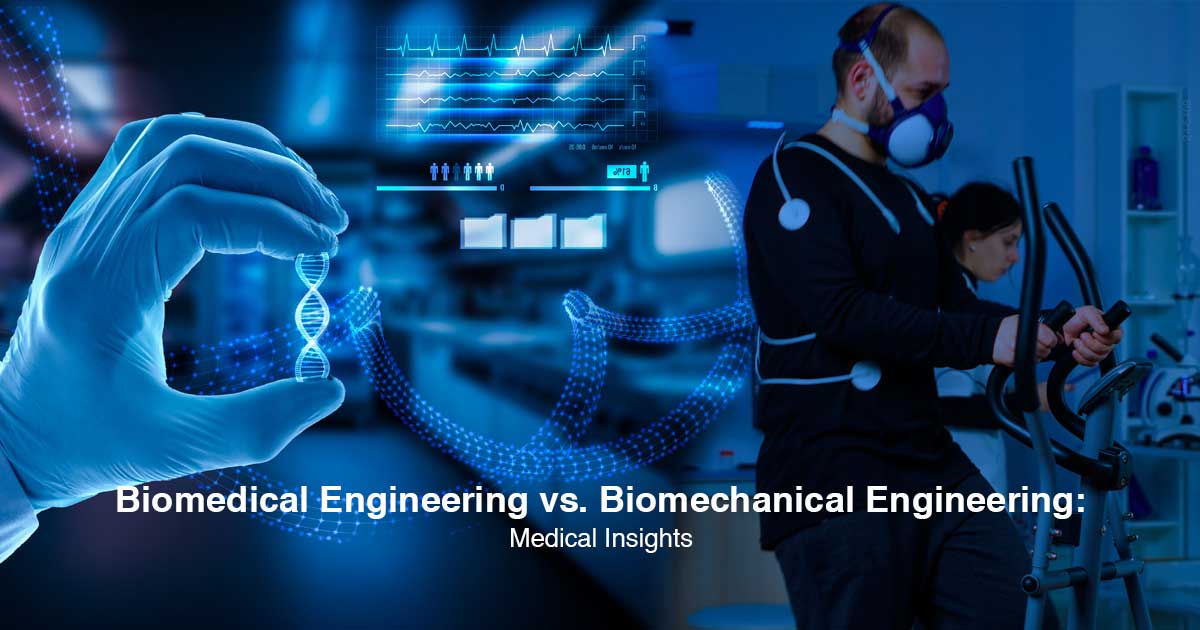Blog Detail


Biomedical Engineering vs. Biomechanical Engineering: Medical Insights
29-04-2024

Biomedical Engineering and Biomechanical Engineering are two interdisciplinary fields in engineering, biology, and healthcare. While they share common ground in their attempt to enhance human health, they diverge in their particular applications and areas of emphasis. They are identified as niche engineering branches that involve engineering principles similar to those of medical sciences aiming to serve and streamline the healthcare industry. Both these fields open the possibilities to explore the vast horizons of the healthcare department along with engineering expertise. Students undertaking studies in these fields can become a part of revolutionising healthcare and offer ground-breaking solutions to biology, medicine and engineering.
Biomedical engineering combines engineering principles with sciences to design and develop devices, equipment, software and computer systems. Its focus is more on technology and medicine that aids in developing human health. On the other hand, biomechanical engineering is about designing, developing, and maintaining equipment and devices related to the human body, such as artificial organs, limbs, etc.
Course duration
The minimum needed qualification to become a biomedical engineer is attaining a bachelor’s degree, which generally takes around four years full-time. Similarly, a bachelor’s degree in biomechanical engineering also takes four years, which is considered enough to gain theoretical knowledge of both engineering and biomedical processes. Both programmes provide a solid foundation in engineering principles, mathematics, and the biological sciences as they delve deeper into specialised areas within each field.
Curriculum
Biomedical engineering programmes offer a multidisciplinary curriculum, combining core engineering courses with biology and medical sciences. Students usually start with foundational courses such as mathematics, physics, chemistry, and basic engineering principles. As they progress, they delve into specialised biomedical courses, such as:
- Biomedical electronics
- Computational biology
- Medical imaging
- Medical device design
- Biomaterials
- Cellular, tissue and genetic engineering
Biomechanical engineering involves applying principles like mass, heat, kinetics and mechanics of materials to study and analyse biological systems. The programme emphasises courses in engineering mechanics, covering topics such as statics, dynamics, and mechanics of materials. These form the basis for understanding how forces and loads affect biological structures. Some other topics that it covers are:
- Thermodynamics and heat transfer
- Engineering design
- Biofluid mechanics
- Biomechanical modelling and simulation
- Biomechanical instrumentation
- Medical imaging techniques
- Biomechanics of human motion
Career opportunities
With both programmes belonging to niche categories, there are vast career opportunities, as not much cut-throat competition is prevalent. Biomedical engineering lends numerous opportunities as one can find lucrative career options in management, lab work, research and development, and consulting, among others. A few of the job roles that you can expect to land after pursuing biomedical engineering are:
- Biomedical researchers engage in back-end research and strategise the advantages and the disadvantages of specific medical devices and instruments
- Manufacturing engineers develop low-cost and high-quality healthcare products
- Bio-material developers, with the help of AI, develop artificial or natural tissue for human use as well as work on detecting, repairing and replacing lost or lifeless organs of the body
- Medical engineering developers develop hardware and software concerning medical devices, i.e., work on technical aspects utilising engineering as well as medical knowledge
Biomechanical engineering is also a dynamic field that merges principles from mechanical engineering with biological sciences to design and create innovative solutions for the human body. This interdisciplinary approach opens up many career opportunities for professionals in this field, such as:
- Bioengineering researchers indulge in lab work and analysis of medical processes that help discover new and innovative solutions for the medical industry
- Quality engineers ensure the quality of medical devices and instruments before they are handed over to the healthcare service departments
- Biomechanical engineers incorporate technology with mechanics to enhance the patients’ lives with artificial organs like liver, heart, and kidney
- Clinical engineers work as clinical engineers with the opportunity to work alongside a doctor and oversee datasets, equipment, and instrument records
Despite their distinctions, biomedical and biomechanical engineering often intersect, especially in areas like prosthetics and orthopaedics. For instance, developing a prosthetic limb requires expertise from both fields. Both disciplines share the common goal of advancing human health through innovative engineering solutions, showcasing the collaborative nature of these fields in shaping the future of medicine and technology. Professionals in these fields can find themselves engaged in various sectors that are not only limited to healthcare but also include pharmaceutical companies, government agencies, academics, and research laboratories. These are some dynamic and promising fields that embrace innovation and commitment towards saving and improving lives and, therefore, have the potential to shape the future of the healthcare industry.